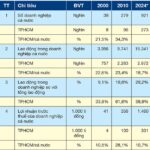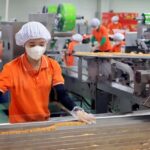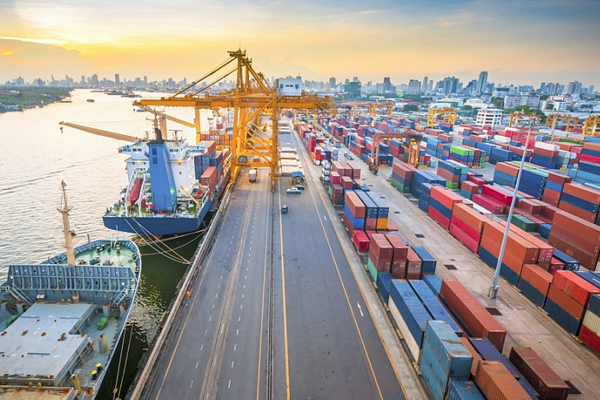At the regular meeting on the morning of May 8 of the Ho Chi Minh City People’s Committee on the socio-economic situation in April and the first four months of the year, the Department of Finance reported that many economic indicators showed high growth compared to the same period.
Specifically, the total retail sales of goods and service revenue were estimated at VND 444,885 billion, up 20%. Tourism revenue reached VND 76,581 billion, up 27.5%; the number of international visitors to the city was estimated at 2.31 million, up 26.2% over the same period last year.
Other sectors also recorded positive recovery signs: public passenger transport increased by 15.6% with more than 183 million passengers; exports increased by 9.07%, reaching USD 16.1 billion; the industrial production index (IIP) increased by 7.9%; FDI reached USD 1.506 billion, a strong increase of 64.6%.
Despite the optimistic growth indicators, Ms. Le Thi Huynh Mai, Director of Ho Chi Minh City Department of Finance, assessed that there are still issues that need special attention. The number of newly established enterprises decreased sharply by 34.6%, registered capital decreased by 52.3% over the same period. At the same time, the number of temporarily suspended enterprises increased by 7.2%, reflecting the hesitation in investment and business of the private sector.

Ho Chi Minh City’s retail and service activities grew strongly in April 2025. Photo: Dao Phuong |
Notably, the disbursement of public investment capital reached only 7.2% of the plan, lower than in previous years.
At the discussion session, Dr. Truong Minh Huy Vu, Director of the Ho Chi Minh City Institute for Development Research, said that the growth in April was largely contributed by two major holidays, especially the 50th anniversary of the reunification of the country.
“Ho Chi Minh City organized the celebration solemnly, safely, and effectively, while combining tourism, trade, and cultural stimulation activities, thereby creating a strong boost for the service sector,” Dr. Huy Vu assessed.
However, he also warned: “This may only be a short wave. If the city does not promptly implement long-term strategies and restructure the economy, growth will not be sustained.”
Mr. Vu also noted that the current increase in industrial production and exports is temporary, largely due to enterprises taking advantage of the 90-day period before the US tax countermeasure policy takes effect to boost exports.
“The April data cannot confirm the recovery of industry and exports. On the contrary, the decrease in imports from China indicates that new orders are still weak, and Ho Chi Minh City is in the process of restructuring its import and export markets,” he said.
Giving an overview of the prospects, Dr. Huy Vu said that after Ho Chi Minh City was re-established on the basis of merging three provinces and cities, this is the “opportunity of the future”. However, to seize the investment wave, Ho Chi Minh City needs a clear economic development strategy, at least in the next two months.
Regarding the US tax countermeasure, Mr. Vo Van Hoan, Vice Chairman of the Ho Chi Minh City People’s Committee, noticed that the city’s exporting enterprises are in a “hesitant” state.
According to April 2025 data, the export sector showed growth, but this is a “fast and hasty” increase to overcome the pressure of tax countermeasures and clear inventory. On the other hand, partner enterprises in the US also increased purchases to avoid high taxes.
“The two governments are negotiating on the tax countermeasure. For sustainable development, enterprises need to transform from ‘made in Vietnam’ to ‘made by Vietnam,’ Mr. Hoan emphasized.
Anh Phuong
– 22:44 05/08/2025
“Unleashing the Business Leader Within: The Ultimate Gateway to Prosperity”
The business landscape is ever-evolving, and a thriving business sector is a testament to a robust and competitive economy. While Ho Chi Minh City boasts the largest economic scale in the country, its position has shifted over the past 50 years. The city now finds itself in a situation where its economic prowess has been surpassed by other localities within Vietnam, and it lags behind in catching up with external competitors.
Unlocking Vietnam’s Economic Growth: The Four Pillars of Transformation
“Vietnam’s path to prosperity lies in a comprehensive development strategy, centered on nurturing private enterprises, efficiently mobilizing financial resources, and harnessing the power of local initiatives. The country’s focus on empowering private enterprises and efficiently managing financial resources will unleash the potential of local communities, ensuring social stability and a thriving economy.”
The New Economic Frontier: Leading the Charge in Ho Chi Minh City’s Renaissance
Half a century has passed since the country’s reunification, and it has been a transformative journey for Ho Chi Minh City. The metropolis has always been vibrant and dynamic, witnessing and driving spectacular changes. Overcoming the challenges of the post-war era, the city has rapidly emerged as a major economic hub, solidifying its position as the nation’s leader.
“Ho Chi Minh City’s Reform Breakthrough: Asserting its Economic ‘Pioneer’ Status”
As Ho Chi Minh City embarks on a new phase of development, it faces not only a plethora of opportunities but also a slew of challenges. The city has begun to outgrow its infrastructure, resulting in bottlenecks that hinder its progress. To maintain its position as a vanguard, Ho Chi Minh City must embrace transformative reforms that match its expanding scale and ambition.
A Vision Proposal: ‘One Center, Three Corridors’ for Ho Chi Minh City’s Future Development
“The proposal to merge Binh Duong and Ba Ria – Vung Tau with Ho Chi Minh City to create a super-economic hub of Vietnam is a visionary move by the country’s leadership. To truly propel Ho Chi Minh City to new heights and unlock its full potential as the nation’s powerhouse, a bold and feasible long-term strategic vision is imperative. This vision transcends administrative boundaries, positioning Ho Chi Minh City at the heart of Vietnam’s economic development strategy. The article introduces the visionary concept of ‘One Center – Three Corridors’ for Ho Chi Minh City, aiming to fulfill this ambitious goal.”





















